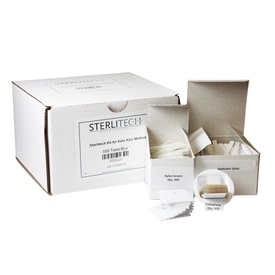Kato-Katz Diagnostic Test Kits for Field Studies

Sterlitech Kato-Katz Test Kits are designed for diagnostic use in the field. Our kit was developed in response to difficulty among research groups, control programs, and health organizations to readily source the materials needed for this testing. Field scientists utilize Kato-Katz tests to identify the presence of parasitic Soil-Transmitted Helminths (STH) eggs in fecal samples from infected patients. It can be used to diagnose individual infection and monitor disease prevalence across communities for epidemiological studies. Compared to other diagnostic methods, the Kato-Katz technique offers the benefit of sample preservation, enabling field samples to be stored for later study.1 It complements the Sterlitech Schistosome Test Kit, which detects parasitic Schistosome worm eggs in urine.
STH worm infections affect a substantial portion of the world’s population living in warm and moist climates with limited access to clean water and sanitation services. When eggs are ingested, or hookworm larvae pass through the skin, STH worms mature and take up residence by attaching to intestinal walls and feeding on the host’s blood after eggs are ingested, or hookworm larvae pass through the skin. Adult worms typically survive for 1 to 2 years and, depending on the species, mature females produce 3000 to 200,000 eggs per day.2 Eggs are shed in the host’s feces to continue the parasite’s lifecycle. If left untreated, infection can result in a range of serious gastrointestinal complications and impaired physical and cognitive development in children. These infections are listed as one of the CDC’s Neglected Tropical Diseases, because they have the potential to be controlled or completely eliminated with proper intervention.
The Kato-Katz kit is contained in a small box for easy use in field hospitals and clinics, allowing medical staff to diagnose infection in remote locations. Included in each kit are the materials and instructions for carrying out 500 tests. Please note that some additional components are needed to perform the method, and a list of these can be found on the product data sheet.
Interested in learning more about the Kato Katz method? Please watch the video below, or read the published procedure.
References:
[1] https://www.who.int/neglected_diseases/preventive_chemotherapy/pctnewsletter11.pdf
[2] https://www.cdc.gov/parasites/sth/index.html
- Most Viewed Blog Articles (5)
- Company News (285)
- Emerging Technologies (64)
- Microbiology and Life Science News (93)
- Water and Fluid Separation News (97)
- Filtration Resources (93)
- Product News (19)


![Join Sterlitech at BIO 2024 [Booth #5558]: Exploring the Future of Biotechnology](https://www.sterlitech.com/media/blog/cache/300x200/magefan_blog/b4.jpeg)



